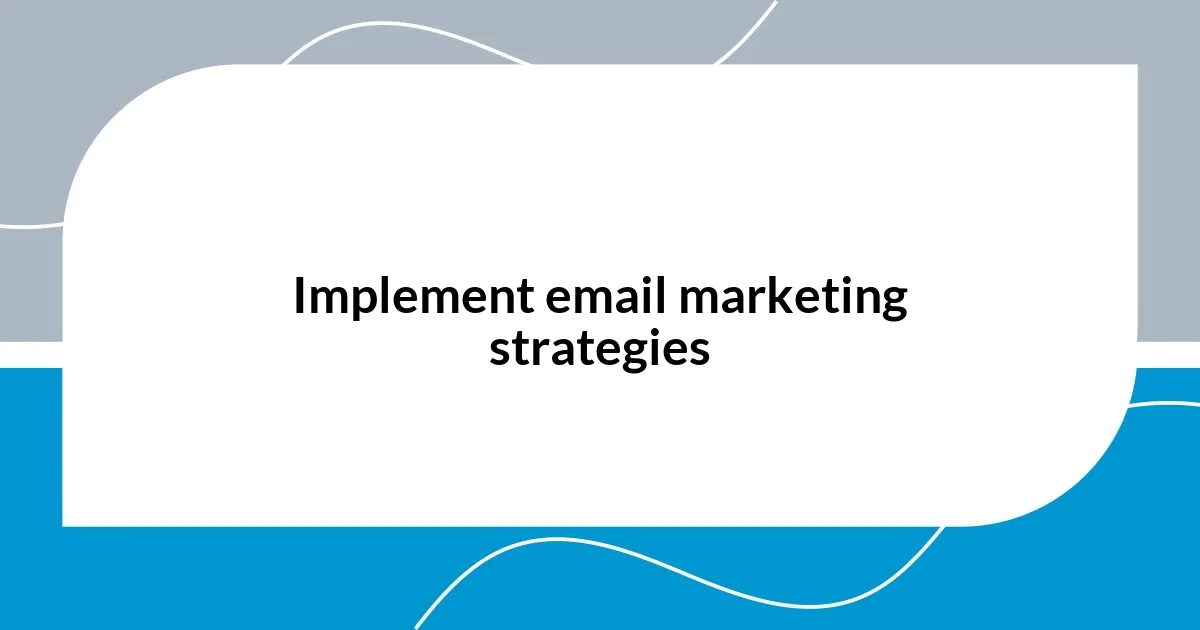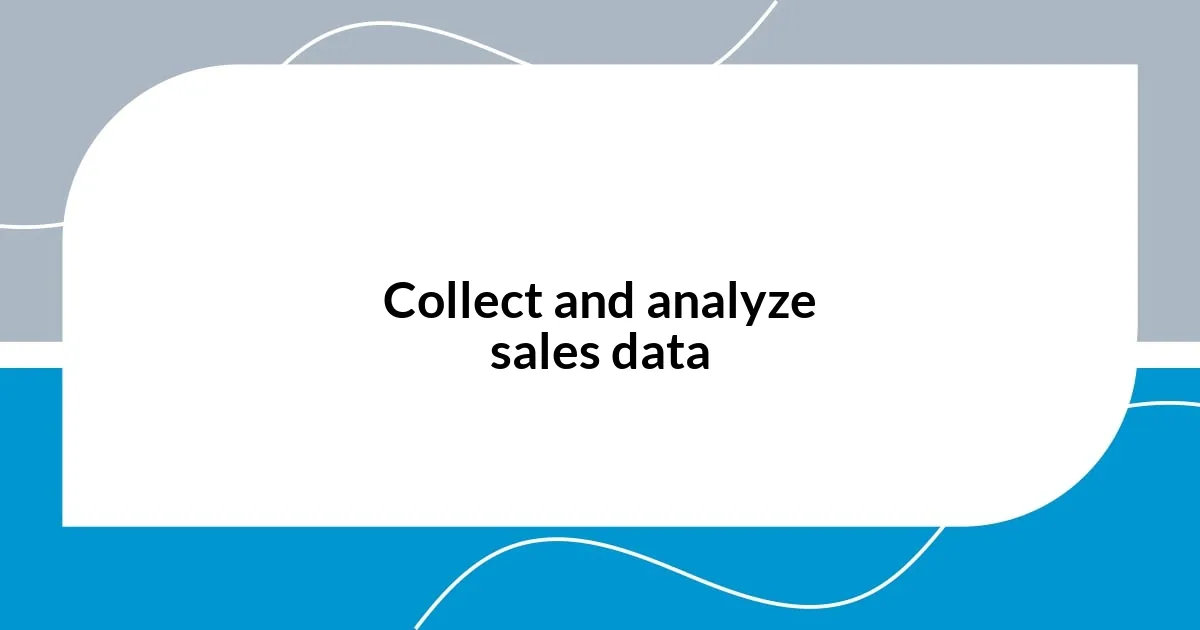Key takeaways:
- Identifying and engaging with the target audience through social media and surveys significantly enhances book sales and community connection.
- Optimizing book listings with compelling descriptions, relevant keywords, and high-quality images increases visibility and attracts more readers.
- Email marketing strategies foster direct connections with readers, offering personalized content that boosts engagement and loyalty.
- Analyzing sales data provides insights into effective marketing strategies, allowing authors to refine their approach and better understand reader preferences.

Identify target audience effectively
Identifying my target audience was a turning point in boosting my book sales. I remember sitting down with a cup of coffee, armed with demographic data and sample profiles, trying to picture who would truly resonate with my story. It was in those quiet moments, imagining my readers’ lives and preferences, that I realized the importance of connecting with them on a deeper emotional level.
I often wondered, who are these readers? What are their struggles, dreams, and interests? By engaging with them through social media platforms and writing forums, I uncovered invaluable insights. This direct interaction not only helped me refine my messaging but also made me genuinely feel part of a community, where I could tailor my book’s themes to address their needs and desires.
It’s fascinating how a simple survey can reveal so much about your audience. I tried it once, and the feedback was eye-opening. Readers shared what had drawn them in and what they were seeking next, making it clear that understanding my audience was not just a one-time exercise but a continuous journey.

Optimize book listings for visibility
Optimizing book listings for visibility is vital to ensuring that potential readers find your work among countless others. I discovered that crafting an engaging book description is key. Initially, I focused solely on summarizing my plot, but then I realized a compelling description should evoke emotion and intrigue. I remember reworking my blurb several times, experimenting with different hooks and tones until one day, a fellow author told me, “Your description reads like a conversation!” That feedback brought a smile to my face and led to an increase in clicks and interest.
When I learned about the importance of keywords, I had a “lightbulb moment.” It was like I had stumbled upon a treasure map. I spent hours researching the best keywords related to my genre. Not only did I use them in my title and description, but I also strategically sprinkled them throughout my author bio. It was rewarding to see my book’s visibility rise as I applied these insights, making it easier for interested readers to find me.
I also can’t stress enough the significance of high-quality images. Initially, I didn’t think much of my cover design. But after receiving feedback that a professional layout gave my book more credibility, I invested in a designer. Seeing my book seemingly transform overnight was exhilarating! The allure of a well-crafted cover paired with SEO-optimized content has proven to be a winning formula for visibility.
| Optimization Aspect | Key Tactics |
|---|---|
| Book Description | Engaging, emotional narrative that draws readers in |
| Keywords | Thorough research, strategic placement in titles and descriptions |
| Images | High-quality, professional cover design for appeal |

Leverage social media platforms
Leverage social media platforms. Social media became my best friend in reaching new readers and engaging with my audience in real-time. I vividly recall the thrill of sharing snippets of my writing on platforms like Instagram and Twitter, where I could connect with book lovers instantly. Each post felt like sending out a little piece of my journey, and the interactions I received were both invigorating and motivating. I remember one enthusiastic comment from a reader who said, “I can’t wait to read the whole book!”—a moment that filled me with warmth and determination.
To maximize my presence, I adopted various strategies across platforms. Here’s what worked for me:
- Consistent Posting: I created a schedule to share updates regularly, ensuring my followers knew what to expect.
- Engaging Content: Beyond just book promotions, I shared personal stories, behind-the-scenes looks, and writing tips to build a stronger connection.
- Utilizing Hashtags: Researching and using the right hashtags helped me reach wider audiences and join relevant conversations.
- Interactive Features: Polls and Q&A sessions on Stories drew readers in and made them feel involved in my creative process.
- Collaborations: Partnering with other authors and influencers opened new doors, allowing me to tap into their audiences.
By embracing social media as a dynamic tool, I felt my book sales surge as I fostered a vibrant community around my work.

Implement email marketing strategies
Implementing email marketing strategies changed the game for my book sales. I vividly remember sitting at my kitchen table, realizing that my scattered approaches to reaching readers needed focus. Crafting a monthly newsletter allowed me to share not just updates about my books, but personal stories and insights that connected me directly with my audience. Have you ever felt that instant connection when someone shares their experience with your work? That’s the magic email marketing can create.
Building my email list took time and effort, but it was well worth it. I started by offering a free short story to anyone who signed up. It was thrilling to see my subscriber count grow every day. Each new email felt like a warm invitation to share my writing journey with someone who genuinely cared. Through this base, I was able to share exclusive previews, special discounts, and even behind-the-scenes glimpses of my writing process, making my readers feel like part of my creative family.
What really stands out to me, though, is the power of personalization. I took the time to segment my audience based on their preferences, sending tailored emails that resonated with each group. Whether it was a new release in a genre they loved or updates on upcoming projects, personalization led to higher open rates and engagement. It’s like having a one-on-one conversation with readers who are excited to hear from you. In this digital age, who wouldn’t want to feel connected to an author they admire?

Utilize paid advertising options
Exploring paid advertising options significantly boosted my book sales, and I recall my initial hesitation before diving in. It felt daunting, but once I experimented with Facebook and Instagram ads, the results were undeniable. I vividly remember the first day I launched an ad—it was like throwing a stone into a pond and watching the ripples spread across a vast audience.
The beauty of paid advertising is its precision. By targeting specific demographics, I reached readers who were genuinely interested in my genre. For instance, I created an eye-catching visual with a powerful tagline that resonated with my audience’s interests. I still feel a rush of excitement every time I get feedback on an ad—I even had someone message me saying they’d never heard of my book before but were intrigued enough to purchase it immediately. Can you imagine the thrill of knowing your words reached someone who might become a lifelong reader?
Moreover, analyzing ad performance allowed me to fine-tune my approach continuously. I experimented with different copy and visuals, tracking what resonated best. One time, I found that highlighting a compliment from a well-known reviewer elevated clicks significantly. The iterative process felt like collaborating with my readers, as each campaign taught me something new about how to connect with them. Investing in paid advertising truly transformed my reach, and those moments of connection are what keep me motivated to create more.

Collect and analyze sales data
Collecting and analyzing sales data became one of the most enlightening experiences in my author journey. I remember the first time I dove into my sales dashboard, feeling a mix of curiosity and apprehension. What I discovered was a treasure trove of insights, showing me exactly where my greatest sales came from—was it social media, email marketing, or perhaps word-of-mouth buzz? It was eye-opening, and honestly, a bit empowering too.
The process of analyzing this data wasn’t just about numbers; it felt personal. I could see spikes in sales corresponding to specific promotions or new releases, making me realize which strategies hit home with my readers. For example, after noticing a surge in sales following a particular post on Instagram, I got excited about planning more similar content. Do you ever consider how a single post could ripple through your audience and generate enthusiasm? That realization pushed me to engage in a more strategic approach to my marketing efforts.
I also started keeping notes on customer feedback, which complemented the sales data beautifully. Tracking not just how many copies were selling, but also what readers were saying about my books illuminated patterns in preferences. A heartfelt message from a reader who loved a twist in my plot could lead to more books being sold in that genre. By blending qualitative insights with quantitative data, I gained a richer understanding of my readers. Isn’t it fascinating how these numbers can tell stories beyond just sales? Each data point connects directly to reader experiences, shaping the path forward for my writing career.

Foster community engagement for loyalty
Building a community around my books has been a game changer for fostering loyalty among my readers. I remember hosting a virtual book club meeting one evening, where I opened the floor for discussion. The energy was infectious as readers shared their thoughts, and I felt a deep connection forming. Isn’t there something special about seeing your words spark real conversations among readers?
Encouraging readers to share their own stories and experiences related to my books created a bond that went beyond the pages. I was pleasantly surprised when one reader posted a photo of my book alongside their favorite tea, saying it made for the perfect reading experience. Moments like that remind me—it’s not just about selling a book; it’s about creating shared memories. And when readers feel part of something bigger, they naturally return for more.
Furthermore, I’ve found that engaging with my community on social media is crucial. I often respond to comments or engage in Q&A sessions, which makes my readers feel seen and valued. It’s powerful; they’re not just customers; they’re part of my creative journey. I still recall a fan who sent me a heartfelt message after a live stream, stating how my writing helped them through a tough time. Those interactions motivate me to keep writing, knowing I’m not just telling stories but also building a supportive tribe. How could I not cherish that connection?